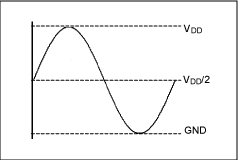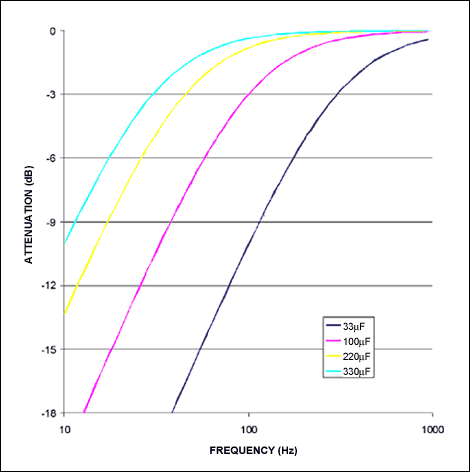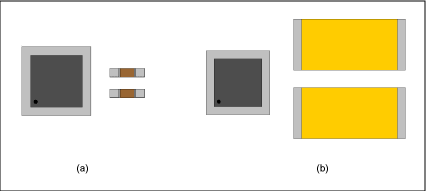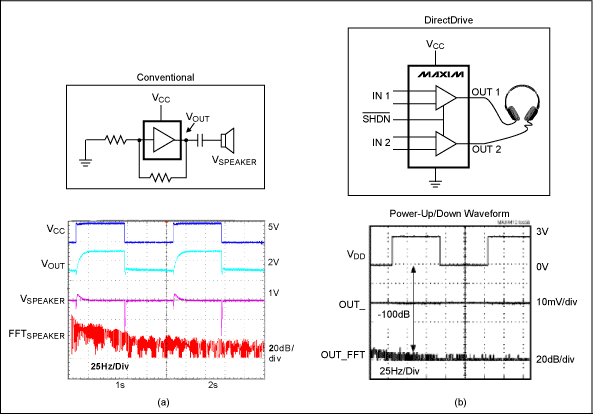Abstract: DirectDrive's proprietary architecture¹ eliminates the DC blocking capacitor required by the traditional headphone amplifier output. This article describes the DirectDrive technology, including the working principle and advantages of the technology.
Traditional Headphone Amplifier The traditional headphone amplifier used in most battery-powered electronic products is powered by a single power supply, with a signal swing between positive voltage and ground level. As a result of this design, the amplifier can only pass positive voltage signals. However, the audio signal usually changes positively and negatively. Therefore, the traditional single-supply amplifier needs to add DC bias before receiving the audio signal. This DC bias is usually half of the supply voltage to achieve the maximum signal swing (Figure 1).

Figure 1. Traditional output waveform
Although DC bias is necessary for the amplifier circuit, the speaker requires that the signal is not DC biased. When a DC bias is connected to the speaker, the speaker cone will shift from the middle balance point to the side of the maximum offset point. This means that the speaker will not be able to generate too much sound pressure without distortion. The DC level also introduces DC losses in the speaker coil, which increases power consumption and causes unnecessary heating of the speaker. In extreme cases, such heat generation may permanently damage the speakers.
In order to achieve the isolation of the loudspeaker from the DC bias, DC blocking capacitors are usually required. This capacitance and the resistive load connected in most cases form a high-pass filter. Since the typical headphone load is equivalent to a 32Ω resistor, the capacitance must be large enough to avoid filtering out the useful part of the audio bandwidth. If the lower limit of the effective bandwidth is 20Hz, a minimum capacitance of 250µF must be used to ensure that the attenuation at 20Hz does not exceed 3dB. If a 16Ω earphone is used, a minimum DC blocking capacitor of 500µF is required. Although some systems have enough space to use such large-sized inexpensive aluminum electrolytic capacitors, most portable devices still do not have enough space to accommodate such large capacitors. For the latter, more expensive tantalum capacitors must be used to save space, but even this type of capacitor still takes up a lot of board space. Therefore, small capacitors are often used to save space and cost, but this comes at the expense of a flat frequency response of 20 Hz. Figure 2 shows the frequency response of capacitors with different standard sizes.

Figure 2. Frequency response of a traditional headphone amplifier (16Ω load)
DirectDrive technology DirectDrive headphone amplifiers do not require DC bias, thus eliminating the need for DC blocking capacitors at the output. Although the DirectDrive headphone amplifier still uses a single power supply, the amplifier can handle positive and negative signals. The on-chip charge pump generates a negative voltage with the same swing as the positive voltage, allowing negative signals to be accepted. Due to the dual power supply, the amplifier no longer works under single power supply. As shown in Figure 3, the op amp will be biased to ground.

Figure 3. Amplifier output waveform using DirectDrive technology
The charge pump used by DirectDrive only requires two small-sized ceramic capacitors: a flying capacitor and a holding capacitor. The typical value of these two capacitors is 1µF, and the minimum specification is 0402. Compared with the 220µF output capacitor used in traditional headphone amplifiers, this greatly saves space and has more excellent performance (Figure 4).

Figure 4. a) Two 1µF charge pump capacitors compared to b) Two 220µF output coupling capacitors, which saves space
The advantages of DirectDrive are obvious. DirectDrive eliminates the output coupling capacitors required by traditional headphone amplifiers, and has significant advantages in overall solution size and cost. At the same time, DirectDrive technology also has many other advantages.
Noise suppression
One of the most significant advantages of DirectDrive technology is that it greatly reduces noise. In a traditional headphone amplifier, the output capacitor must be charged each time the amplifier is enabled, and discharged when turned off. During this charging / discharging process, current flows through the earphones, resulting in a more obvious popping noise (Figure 5). DirectDrive eliminates the need for capacitance, which eliminates the main source of noise.

Figure 5. Data shows noise in two types of amplifiers: a) traditional headphone amplifier, b) DirectDrive headphone amplifier
Better bass performance The high-pass filter formed by the DC blocking capacitor and the resistive headphone load will also affect the sound effect. In most systems, it is impossible to use the same capacitor to achieve a frequency response in the entire range from 20Hz to 20kHz. In order to save space and cost, a capacitor with a smaller point than the ideal capacitor is often used, thereby improving the low-frequency roll-off point, thereby reducing the bass performance of the system. If you use 16Ω headphones, the impact on bass performance will be greater. A typical system is usually designed for 32Ω headphones; when 16Ω headphones are connected, the low-frequency cutoff frequency will increase twice, which will further reduce the bass frequency.
However, using DirectDrive technology will completely eliminate the high-pass filter, so the input coupling capacitor can be used to set the corner frequency. Since the input impedance of the amplifier is usually greater than 10kΩ, only 1µF or even a smaller capacitor is needed to ensure the entire audio bandwidth.
Low voltage operation
DirectDrive technology allows the headphone amplifier to be powered directly from the power supply used by the main digital IC in the system. Because it works under a power supply lower than the battery voltage, the efficiency of the headphone amplifier is improved. In the past, 3.3V or even 2.5V power supply was often used, and now 1.8V power supply is gradually replacing the above power supply. For traditional headphone amplifiers, theoretically, only 1.8mW output power (32Ω load) can be output under 1.8V power supply. However, for the DirectDrive amplifier, since the power supply voltage is doubled, it can output up to 40mW of power at the same power supply voltage. Therefore, the amplifier working in the modern system is based on ensuring the efficiency while still producing sufficient sound intensity.
2VRMS line output amplifier
DirectDrive technology is used in systems that require 2VRMS audio output, which can double the power supply, which is another advantage. Such systems usually have a 5V power supply. However, standard amplifiers powered by 5V usually cannot output 2VRMS; therefore, in order to provide 2VRMS output, a higher power supply is required. Using DirectDrive technology, because the power supply has been doubled on-chip, it is possible to provide an output of more than 2VRMS under the condition of 5V power supply.
Reducing distortion Finally, the output capacitors used in traditional headphone amplifiers can cause significant distortion in low-frequency audio signals. Near the inflection point of the low frequency, the voltage coefficient of the capacitor will become non-linear and at the same time will cause distortion of the audio signal. In some cases, the distortion can be up to 1%, which can be heard and measured (Figure 6). DirectDrive eliminates coupling capacitors, thereby eliminating sources of distortion.

Figure 6. Distortion caused by output coupling capacitors. DirectDrive headphone amplifiers have many improvements over traditional single-supply headphone amplifiers. This technology reduces the size of the solution, saves costs, and improves sound quality, at the cost of only slightly increasing the size of the chip.

Figure 1. Traditional output waveform
Although DC bias is necessary for the amplifier circuit, the speaker requires that the signal is not DC biased. When a DC bias is connected to the speaker, the speaker cone will shift from the middle balance point to the side of the maximum offset point. This means that the speaker will not be able to generate too much sound pressure without distortion. The DC level also introduces DC losses in the speaker coil, which increases power consumption and causes unnecessary heating of the speaker. In extreme cases, such heat generation may permanently damage the speakers.
In order to achieve the isolation of the loudspeaker from the DC bias, DC blocking capacitors are usually required. This capacitance and the resistive load connected in most cases form a high-pass filter. Since the typical headphone load is equivalent to a 32Ω resistor, the capacitance must be large enough to avoid filtering out the useful part of the audio bandwidth. If the lower limit of the effective bandwidth is 20Hz, a minimum capacitance of 250µF must be used to ensure that the attenuation at 20Hz does not exceed 3dB. If a 16Ω earphone is used, a minimum DC blocking capacitor of 500µF is required. Although some systems have enough space to use such large-sized inexpensive aluminum electrolytic capacitors, most portable devices still do not have enough space to accommodate such large capacitors. For the latter, more expensive tantalum capacitors must be used to save space, but even this type of capacitor still takes up a lot of board space. Therefore, small capacitors are often used to save space and cost, but this comes at the expense of a flat frequency response of 20 Hz. Figure 2 shows the frequency response of capacitors with different standard sizes.

Figure 2. Frequency response of a traditional headphone amplifier (16Ω load)
DirectDrive technology DirectDrive headphone amplifiers do not require DC bias, thus eliminating the need for DC blocking capacitors at the output. Although the DirectDrive headphone amplifier still uses a single power supply, the amplifier can handle positive and negative signals. The on-chip charge pump generates a negative voltage with the same swing as the positive voltage, allowing negative signals to be accepted. Due to the dual power supply, the amplifier no longer works under single power supply. As shown in Figure 3, the op amp will be biased to ground.

Figure 3. Amplifier output waveform using DirectDrive technology
The charge pump used by DirectDrive only requires two small-sized ceramic capacitors: a flying capacitor and a holding capacitor. The typical value of these two capacitors is 1µF, and the minimum specification is 0402. Compared with the 220µF output capacitor used in traditional headphone amplifiers, this greatly saves space and has more excellent performance (Figure 4).

Figure 4. a) Two 1µF charge pump capacitors compared to b) Two 220µF output coupling capacitors, which saves space
The advantages of DirectDrive are obvious. DirectDrive eliminates the output coupling capacitors required by traditional headphone amplifiers, and has significant advantages in overall solution size and cost. At the same time, DirectDrive technology also has many other advantages.
Noise suppression
One of the most significant advantages of DirectDrive technology is that it greatly reduces noise. In a traditional headphone amplifier, the output capacitor must be charged each time the amplifier is enabled, and discharged when turned off. During this charging / discharging process, current flows through the earphones, resulting in a more obvious popping noise (Figure 5). DirectDrive eliminates the need for capacitance, which eliminates the main source of noise.

Figure 5. Data shows noise in two types of amplifiers: a) traditional headphone amplifier, b) DirectDrive headphone amplifier
Better bass performance The high-pass filter formed by the DC blocking capacitor and the resistive headphone load will also affect the sound effect. In most systems, it is impossible to use the same capacitor to achieve a frequency response in the entire range from 20Hz to 20kHz. In order to save space and cost, a capacitor with a smaller point than the ideal capacitor is often used, thereby improving the low-frequency roll-off point, thereby reducing the bass performance of the system. If you use 16Ω headphones, the impact on bass performance will be greater. A typical system is usually designed for 32Ω headphones; when 16Ω headphones are connected, the low-frequency cutoff frequency will increase twice, which will further reduce the bass frequency.
However, using DirectDrive technology will completely eliminate the high-pass filter, so the input coupling capacitor can be used to set the corner frequency. Since the input impedance of the amplifier is usually greater than 10kΩ, only 1µF or even a smaller capacitor is needed to ensure the entire audio bandwidth.
Low voltage operation
DirectDrive technology allows the headphone amplifier to be powered directly from the power supply used by the main digital IC in the system. Because it works under a power supply lower than the battery voltage, the efficiency of the headphone amplifier is improved. In the past, 3.3V or even 2.5V power supply was often used, and now 1.8V power supply is gradually replacing the above power supply. For traditional headphone amplifiers, theoretically, only 1.8mW output power (32Ω load) can be output under 1.8V power supply. However, for the DirectDrive amplifier, since the power supply voltage is doubled, it can output up to 40mW of power at the same power supply voltage. Therefore, the amplifier working in the modern system is based on ensuring the efficiency while still producing sufficient sound intensity.
2VRMS line output amplifier
DirectDrive technology is used in systems that require 2VRMS audio output, which can double the power supply, which is another advantage. Such systems usually have a 5V power supply. However, standard amplifiers powered by 5V usually cannot output 2VRMS; therefore, in order to provide 2VRMS output, a higher power supply is required. Using DirectDrive technology, because the power supply has been doubled on-chip, it is possible to provide an output of more than 2VRMS under the condition of 5V power supply.
Reducing distortion Finally, the output capacitors used in traditional headphone amplifiers can cause significant distortion in low-frequency audio signals. Near the inflection point of the low frequency, the voltage coefficient of the capacitor will become non-linear and at the same time will cause distortion of the audio signal. In some cases, the distortion can be up to 1%, which can be heard and measured (Figure 6). DirectDrive eliminates coupling capacitors, thereby eliminating sources of distortion.

Figure 6. Distortion caused by output coupling capacitors. DirectDrive headphone amplifiers have many improvements over traditional single-supply headphone amplifiers. This technology reduces the size of the solution, saves costs, and improves sound quality, at the cost of only slightly increasing the size of the chip.
Neon Lights Near Me,Natural Light Neon Sign,Custom Led Light Signs,Flexible Neon Light
Tes Lighting Co,.Ltd. , https://www.neonflexlight.com
